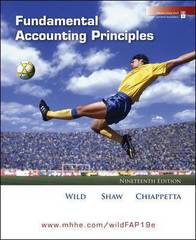Question
After reading the Audit and Materiality of Inventory Case Study,what audit procedures did the auditors apparently fail to follow that should have detected Kumar's fraudulent
After reading the Audit and Materiality of Inventory Case Study,what audit procedures did the auditors apparently fail to follow that should have detected Kumar's fraudulent increase of inventory and what implications would there be to an auditor of failure to detect material fraud as described here?
Audit and Materiality of Inventory
Ando Company, a diversified manufacturer, has six divisions that operate throughout the United States and Puerto Rico. Ando has historically allowed its divisions to operate autonomously. Ando does not have an internal audit department and corporate intervention occurs only when planned results were not obtained. Ando has a policy of hiring competent people. Management is fairly conservative in terms of accounting principles and practices, but employee compensation depends, in large part, on performance.
JP Kumar is the general manager of the Appliance Division that produces a variety of appliances. Kumar has been able to improve profitability of the division each of the prior five years. Much of the improvement came through cost cutting, including, a substantial reduction in control activities over inventory. Recently a new competitor has entered the market and has offered substantial price discounts in an effort to grab market share. Kumar is concerned because if profitability is not maintained, his bonus will be reduced.
Kumar decided that the easiest way to make the Appliance Division appear more profitable was through manipulating the inventory, which was the largest asset on the books. Kumar found that by increasing inventory by 4 percent, income could be increased by 8 percent. With the weakness in inventory control, he felt it would be easy to overstate inventory. Employees count the goods using count sheets, and Kumar was able to add two fictitious sheets during the physical inventory, even though the auditors were present and were observing the inventory. A significant amount of inventory was stored in racks that filled the warehouse. Because of their height and the difficulty of test-counting them, Kumar was able to cover an overstatement of inventory in the upper racks. After the count was completed, Kumar added four additional count sheets that added $950,000, or 8.6 percent, to the stated inventory. Kumar notified the auditors of the "omission" of the sheets and convinced them that they represented overlooked legitimate inventory.
The auditors traced the items on these additional sheets to purchase invoices to verify their existence and approved the addition of the $950,000 to the inventory. They did not notify management about the added sheets. In addition, Kumar altered other count sheets before sending them to the auditors by changing unit designations (for example, "six motor mounts" became six "motors"), raising counts, and adding fictitious line items to completed count sheets. These other fictitious changes added an additional $375,000 to the inflated inventory. None of them was detected by the auditors.
Step by Step Solution
There are 3 Steps involved in it
Step: 1

Get Instant Access to Expert-Tailored Solutions
See step-by-step solutions with expert insights and AI powered tools for academic success
Step: 2

Step: 3

Ace Your Homework with AI
Get the answers you need in no time with our AI-driven, step-by-step assistance
Get Started


